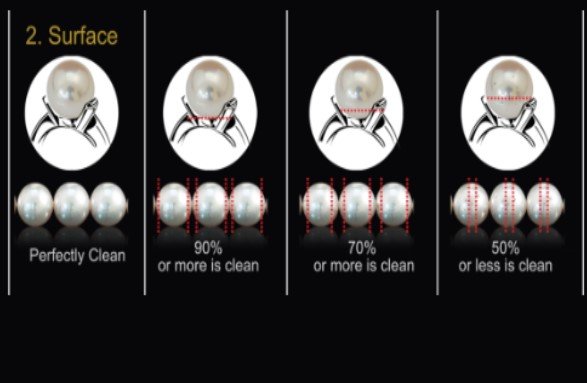Pearl grading plays a key role in evaluating the quality and value of pearls. Whether you’re a collector, an enthusiast, or considering pearls as an investment, understanding the grading process helps ensure informed purchasing decisions. Pearl grading is based on several critical characteristics that define the quality and worth of a pearl. In this article, we’ll explore the key factors that influence pearl grading, its importance, and how to make educated choices when buying pearls.
What is Pearl Grading?
Involves assessing pearls based on specific characteristics that determine their quality and value. These include size, shape, colour, lustre, surface quality, and nacre thickness. Each of these factors contributes to a pearl’s overall beauty, rarity, and desirability. By evaluating these features, experts assign grades that reflect the quality and value of the pearl.
Importance of Pearl Grading
Pearl grading is essential for several reasons:
- Accurate Quality Assessment: Understanding how pearls are graded allows buyers to evaluate their quality with confidence. Knowing the grading system ensures that you’re selecting pearls that meet your expectations for appearance and value.
- Determining Value: A pearl’s grade directly impacts its market value. By understanding the key grading criteria, buyers can make informed decisions, avoiding overpayment for pearls that don’t meet their desired quality.
- Making Informed Decisions: With knowledge of grading parameters, buyers can select pearls that align with their preferences. Collectors may prioritize lustre and surface quality, while investors might focus on nacre thickness and size.

Key Grading Parameters
Pearl grading is primarily based on the following important criteria:
Size
Size is one of the most significant factors in pearl grading. Pearls are measured in millimetres, and larger pearls are typically more valuable due to their rarity. Producing larger pearls is more challenging, especially in the case of saltwater pearls, making them highly sought after.
- Freshwater Pearls: These are usually smaller in size and come in more variable shapes.
- Saltwater Pearls: Found in oceans like the South Sea and Tahiti, these pearls tend to be larger, rounder, and more uniform, adding to their value.
Shape
Shape plays a crucial role in a pearl’s desirability. Round or nearly round pearls are more symmetrical and attractive, making them highly valued.
- Round Pearls: More sought after due to their uniformity.
- Non-round Pearls: Shapes such as baroque or oval may be less desirable and typically graded lower.
Color
The colour of a pearl affects its appeal and value. Pearls come in a wide range of colours, from white and cream to gold and black.
- White Pearls: Often the most traditional and sought-after, especially freshwater pearls
- Coloured Pearls: Racoloursors like pink, gold, or silver tend to be more valuable due to their uniqueness.
Luster
Luster refers to how a pearl reflects light. Pearls with high lustre have a bright, mirror-like surface, making them more desirable due to their brilliance.
- High Luster Pearls: Reflective and enhance a pearl’s beauty.
- Low Luster Pearls: Less reflective and valued at a lower grade.
Surface Quality
The surface quality of a pearl impacts its attractiveness. Pearls with fewer blemishes are more desirable.
- Flawless Pearls: Pearls with minimal surface imperfections are highly valued.
- Blemished Pearls: Pearls with noticeable flaws tend to be less valuable.
Nacre Thickness
Nacre thickness refers to the layers of material that form the pearl’s outer surface. Thicker nacre contributes to durability, lustre, and overall quality.
- Thicker Nacre Pearls: Tend to have richer luster and greater durability.
- Thinner Nacre Pearls: Typically exhibit a duller appearance and are less durable.
The History and Evolution of Pearl Grading
The practice of pearl grading dates back thousands of years. Historically, natural pearls were more prevalent, and grading was often more intuitive. However, with the rise of cultured pearls in the 20th century, more structured grading systems emerged, aiming to ensure consistency and fairness in evaluating pearl quality.
Today, organizations like the GIA (Gemological Institute of America) and the CPAA (Cultured Pearl Association of America) play important roles in establishing standardized grading systems. These systems help ensure consistency in assessing pearl quality, allowing buyers to make confident decisions.
The Pearl Grading Process
The process of grading pearls involves evaluating key characteristics to determine their quality:
- Size Measurement: Pearls are measured for diameter. Larger pearls are graded higher due to their rarity.
- Shape Evaluation: Pearls that are round or nearly round are preferred for their symmetry.
- Colour Assessment: Rare colours and vibrant hues are valued higher.
- Luster Inspection: Pearls with high luster are considered more desirable.
- Surface Quality Check: Minimal surface imperfections enhance the pearl’s overall appeal.
- Nacre Thickness Testing: Pearls with thicker nacre are valued more due to their durability blusterer.
International Bodies and Their Role in Pearl Grading
Several organizations contribute to setting standards for pearl grading:
- GIA (Gemological Institute of America): Provides globally recognized grading standards for pearls.
- CPAA (Cultured Pearl Association of America): Certifies pearl grading, particularly for cultured pearls, ensuring consistent evaluation.
Types of Pearls and Their Grading
The grading process varies between different types of pearls:
- Freshwater Pearls: Smaller, more variable in shape. Grading focuses on size, lustre, and surface smoothness.
- Saltwater Pearls: Found in oceans like the South Sea and Tahiti, these pearls are larger and rounder, valued for superior lustre and surface quality.
- Cultured Pearls: Grown through human intervention, their grading standards are stricter due to controlled production methods.
How to Buy Graded Pearls
When purchasing pearls, paying attention to key grading parameters ensures you select high-quality gems:
- Lustre: Pearls with a high lustre will have a bright, reflective surface.
- Size: Larger pearls are typically more desirable.
- Shape: Pearls with round or nearly round shapes are preferred.
- Surface Quality: Look for pearls with minimal surface imperfections.
- Colour: Unique colours are often more valuable.
Conclusion
Understanding pearl grading empowers buyers to make informed decisions and select pearls that meet their expectations for quality and value. The grading of pearls relies on key factors like size, shape colour lustre, surface quality, and nacre thickness. With a clear understanding of these parameters, buyers can confidently evaluate pearls, ensuring they receive fair pricing and choose pearls that suit their preferences. As pearl grading continues to evolve, standardized systems will help maintain fairness and consistency, allowing buyers to appreciate the beauty and value of pearls with confidence.



